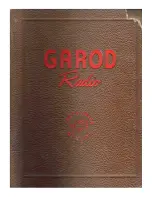
HF-250 User Manual
HF250 User Manual
to the mains outlet, and it is a wise safety precaution to
disconnect it when the receiver or clock are not in use.
In the United Kingdom the power supply is fitted with a
three-core mains lead, and the earth connection
(yellow/green) is connected to the negative (Earth
Connection ground) terminal of the receiver.
This provides a reasonable earth connection for the
receiver, but in some cases, where mains-borne interference
is prominent, it will be necessary to provide the receiver with
a good RF earth, either in addition to the mains earth or in
some cases instead of it. If the receiver is used with any
other mains power supply it should be able to comply with
BSI standards relating to Class 2 insulation.
External Loudspeaker.
A small internal loudspeaker is provided in the HF-250 so
that it is self contained, but although it can provide
reasonable all round audio quality, clearly in the limited
space available compromise has to be made. You will find
that if the volume control is set to a high level there may be
some audio feedback caused by vibration induced by the
internal loudspeaker. If it is necessary to operate the
receiver for long periods at high audio levels the use of an
external loudspeaker is recommended.
Because the HF-250 is capable of giving a high quality audio
signal, we suggest you use a good external loudspeaker, a
small bookshelf type Hi-Fi unit is satisfactory. We can
provide a suitable unit as an optional accessory with the
correct connecting lead for the HF-250. Any external
loudspeaker should have an impedance of 4 to 8Q.
Record Output.
Many keen listeners like to tape record any interesting
stations they hear, and a low level audio output has been
provided, also a pair of relay contacts for switching on the
tape recorder in connection with the built in timer.
The record out socket accepts a 3.5mm mono jack plug and
provides a level suitable for feeding into the line input of
most tape recorders or amplifier systems. An attenuating
resistor should be added in the lead if feeding directly into
the microphone input of a cassette recorder. The output
level at this socket is not affected by the Volume or Tone
controls, so that the loudspeaker can be used to monitor
whilst recording. The record output can also be used for
driving most types of receiver ancillary equipment such as
RTTY, Facsimile or Morse Code decoders. The output level
is about 350 mV RMS from a source impedance of 5k.
Types of Signal.
The HF-250 is equipped to receive most types of
transmission likely to be encountered within its tuning range,
and although most users will be familiar with these, here is a
short section on this topic that may be useful to the
beginner.
AM (Amplitude Modulation).
This was the earliest method used of audio modulation of an
RF carrier wave, and is still almost universally used for long,
medium and short wave broadcasting. An AM signal is fairly





































